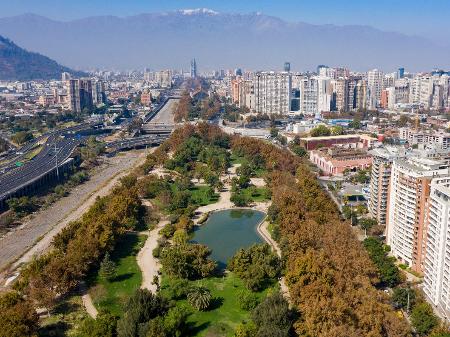RIO DE JANEIRO, BRAZIL – Plaza Italia or Plaza de la Dignidad – as it has been renamed by some in honor of citizens’ claims- was the place where everything has happened since October 18th, when the explosion in Chile began.
“It is a symbol. The square has become a memorial to repression. On the neighborhood walls the new Chile is recounted and what it demands. There hadn’t been a day since October 18th that the demonstrations stopped. Until the pandemic,” said Trinidad Lopetegui (Santiago, 1989), who from the very beginning of the demonstrations watched the development of this living square, day and night on the front line.

A visual artist, she runs the CIMA contemporary art gallery, a venue that has become the eyes of uprisings. Installed on the top floor of a 1950s building, she broadcast what was happening live from the roof.
“Citizens complain about an unsustainable neoliberal system that does not prioritize human beings,” says the Chilean cultural manager. “It’s a transversal movement that transcends the left and right-wings. We take it as a duty: to report everything without intervention”, she recalls.
First they used a telephone, then the security cameras of the gallery itself, and finally a special device to stream. The televisions offered them money to use the venue and record, but they refused. To move from the offices to the 100 square meter terrace – where the camera is installed – they had to protect themselves so as not to inhale the tear gas that rose up to the 11th floor.
Their YouTube channel reached over 18 million views, 89,000 subscribers and 11,750 viewers simultaneously. They posted 382 videos. They are followed by users from all over the planet, but mainly from Argentina, United States, Spain, Peru and Mexico.
“One time, a neighbor lost her mother in a demonstration and found her thanks to the broadcast. We unintentionally became a platform of public utility,” she says.
But what used to be vociferous and dynamic – shouts, songs, music, drums – with the pandemic everything became quiet: “Now there is a desolating, tremendous, striking silence,” says Trinidad Lopetegui. It was a kind of brake that placed the country in a bipolar position. In October, it was claimed that Chile had awakened.
Chile’s economy suffered. But Covid-19 abruptly stopped the uprising and the country seems to be living in a kind of limbo. Some protesters in early March believed that the pandemic was a device by the powerful to prevent change.
Surprisingly, however, the Plaza de la Dignidad protesters quickly complied with the orders to remain at home. “Most were aware of this and went into confinement immediately,” says the visual artist.
“The Covid-19 stressed the significance of social demands like public health.”
Chile is the Latin American country that has performed the most Covid-19 tests: in mid-April it reached the mark of some 118,000 tests, with a capacity of about 8,000 daily in approximately fifty public and private laboratories.
The government has based its strategy on a high number of tests and on “selective and dynamic” quarantines in only a few municipalities, established according to the number of infections.
Unlike other countries in the region, total containment was not implemented, despite pressure from local authorities. Since the first case of the disease was reported on March 3rd, protests stopped overnight, partly because of curfews and the state of emergency.
Chile’s greatest concern is still the number of ventilators, which the administration has centralized from the public and private systems. A few days ago, the Ministry of Health reported there were 538 ventilators available nationwide, distributed by the central government according to regional requests.
The first case of coronavirus was reported on March 3rd, and Sebastián Piñera’s government decreed a state of emergency exception – with military personnel on the streets, such as during the outbreak of protests – a curfew, suspension of classes and closure of businesses.

He stands firm in his decision not to establish full quarantine at the national level, but only in some areas, which change according to contagion. Other than for some organized pot-banging protest in a neighborhood, these past weeks demonstrations have virtually stopped, although in late April several groups challenged the authorities with small-scale gatherings that were repressed.
A few weeks ago the President seized on the stillness of the square and, in a harshly criticized move, got out of his car to photograph himself at the epicenter of protests: “I haven’t committed any crime (…), nobody owns this place”, Piñera explained later.
The major question in Chile is what will happen with social mobilization once the health emergency is over. Trinidad Lopetegui, who has the pulse of the streets on her retina, believes it will resurface with force: “The Covid-19 has emphasized the significance of social demands such as public health and great inequalities, causing greater indignation and anger among the people,” she says.
From the top of the building, despite the silence, it is possible to notice the tracks of a crowd that is now confined. On the tarmac one can still read: historical. It was the word that women wrote in Plaza Italia on March 8th, when about two million Chileans took to the streets to march, demonstrating the power of the social movement that feminism has led. It was the last great gathering before the blackout, which the CIMA gallery continues to relentlessly broadcast.

